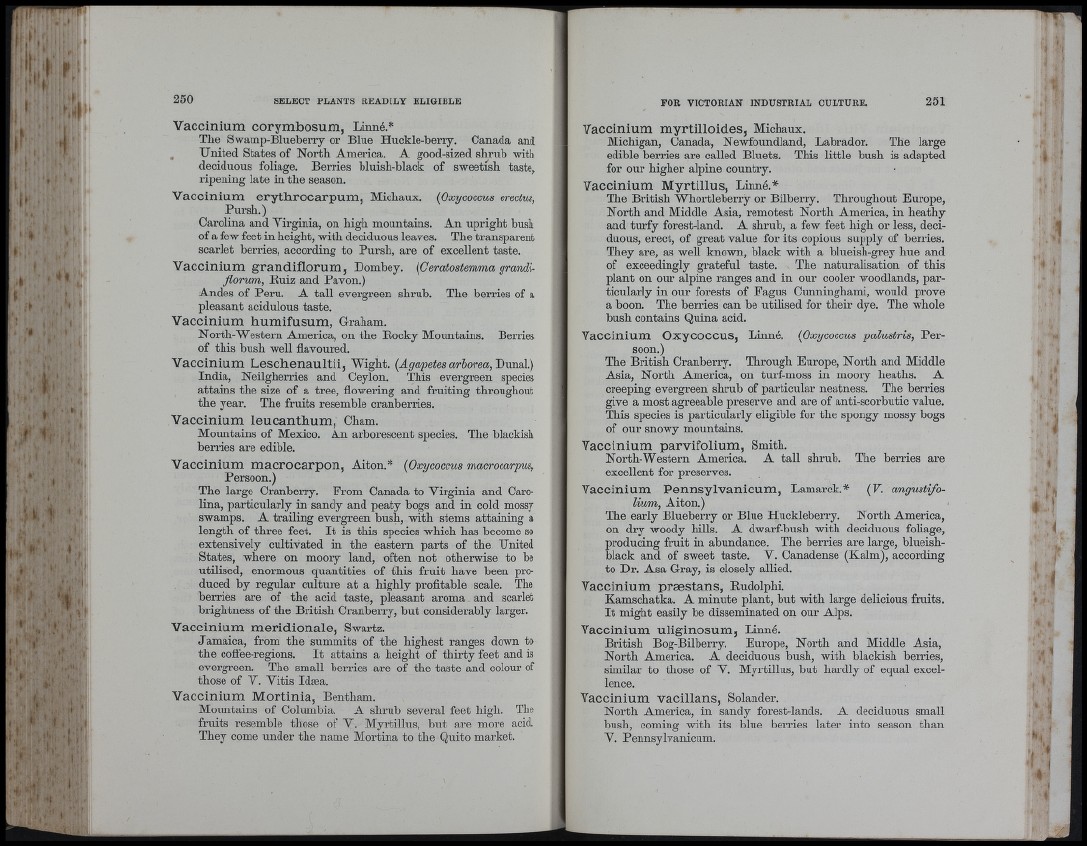
Vaccinium corymbosum, Linné.*
The Swamp-Blueberry or Blue Huckle-berry. Canada and
United States of North Ameidca. A good-sized shrub with
deciduous foliage. Berries bluish-black of sweetish taste,
ripening late in the season.
Vaccinium erythrocarpum, Michaux. (Oxycoccus erectus,
Pursh.)
Carolina and Virginia, on high mountains. An upright bush
of a few feet in height, with deciduous leaves. The transparent
scarlet berries, according to Pursh, are of excellent taste.
Vaccinium grandiflorum, Dombey. (Ceratostemma grandi-
fiorum, Buiz and Pavon.)
Andes of Peru. A tall evergreen shrub. The berries of a
pleasant acidulous taste.
Vaccinium humifusum, Graham.
Noi’th-Western America, on the Bocky Mountains. Berries
of this hush well flavoured.
Vaccinium Leschenaultii, Wight. {Agapetes arborea, Dunal.)
India, Neilgherries and Ceylon. This evergreen species
attains the size of a tree, flowering and fruiting throughout
the year. The fruits resemble cranberries.
Vaccinium leucanthum, Cham.
Mountains of Mexico. An arhoiæscent species. The blackish
berries are edible.
Vaccinium macrocarpon, Aiton.* [Oxycoccus macrocarpus,
Persoon.)
The large Cranberry. Prom Canada to Virginia and Carolina,
particularly in sandy and peaty bogs and in cold mossy
swamps. A trailing evergreen hush, with stems attaining a
length of three feet. I t is this species which has become so
extensively cultivated in the eastern parts of the United
States, where on moory land, often not otherwise to be
utilised, enormous quantities of this fruit have heen produced
by regular culture at a highly profitable scale. The
berries are of the acid taste, pleasant aroma and scarlet
brightness of the British Cranberry, but considerably larger.
Vaccinium méridionale, Swartz.
Jamaica, from the summits of the highest ranges down to
the cofiee-regions. I t attains a height of thirty feet and is
evergreen. The small berries are of the taste and colour of
those of V. Vitis Idæa.
Vaccinium Mortinia, Bentham.
Mountains of Columbia. A shrub several feet high. The
fruits resemble those of V. Myrtillus, but are more acid.
They come under the name Mortina to the Quito market.
Vaccinium myrtilloides, Michaux.
Michigan, Canada, Newfoundland, Labrador. The large
edible berries are called Bluets. This little bush is adapted
for our higher alpine country.
Vaccinium Myrtillus, Linné.*
The British Whortleberry or Bilberry. Throughout Europe,
North and Middle Asia, remotest North America, in heathy
and turfy forest-land. A shrub, a few feet high or less, deciduous,
erect, of great value for its copious supply of berries.
They are, as well known, black with a hlueish-grey hue and
of exceedingly grateful taste. The naturalisation of this
plant on our alpine ranges and in our cooler woodlands, particularly
in our forests of Eagus Cunninghami, would prove
a boon. The berries can be utilised for their dye. The whole
bush contains Quina acid.
Vaccinium Oxycoccus, Linné. [Oxycoccus palustris, Persoon.)
The British Cranberry. Through Europe, North and Middle
Asia, North America, on turf-moss in moory heaths. A
creeping evergreen shrub of particular neatness. The berries
give a most agreeable px’eserve and are of anti-scorbutic value.
This species is particularly eligible for the spongy mossy bogs
of our snowy mountains.
Vaccinium parvifolium, Smith.
North-Western America. A tall shrub,
excellent for preserves.
Vaccinium Pennsylvanicum, Lamarck.*
Hum, Aiton.)
The berries are
(F. angustifo-
North America,
The early Blueberry or Blue Huckleberry,
on dry woody hills. A dwarf-bush with deciduous foliage,
producing fruit in abundance. The berries are large, blueish-
black and of sweet taste. V. Canadense (Kalm), according
to Dr. Asa Gray, is closely allied.
Vaccinium præstans, Budolphi.
Kamschatka. A minute plant, but with large delicious fruits.
I t might easily be disseminated on our Alps.
Vaccinium uliginosum, Linné.
British Bog-Bilberry. Europe, North and Middle Asia,
North America. A deciduous bush, with blackish berries,
similar to those of V. Myrtillus, but hardly of equal excellence.
Vaccinium vacillans, Solander.
North America, in sandy forest-lands. A deciduous small
bush, coming with its blue berries later into season than
V. Pennsylvanicum.
I I
j
fv
' 'i: 'W